We all know how bad plastic is for the earth, and now it’s our turn to do a better job of reducing plastic. We’ve rounded up our best tips and simple ideas to help you reduce plastic waste while traveling or at home.
This guide is packed full of insider tips, DIY solutions, eco-friendly products, and easy swaps so you can start using less plastic today!
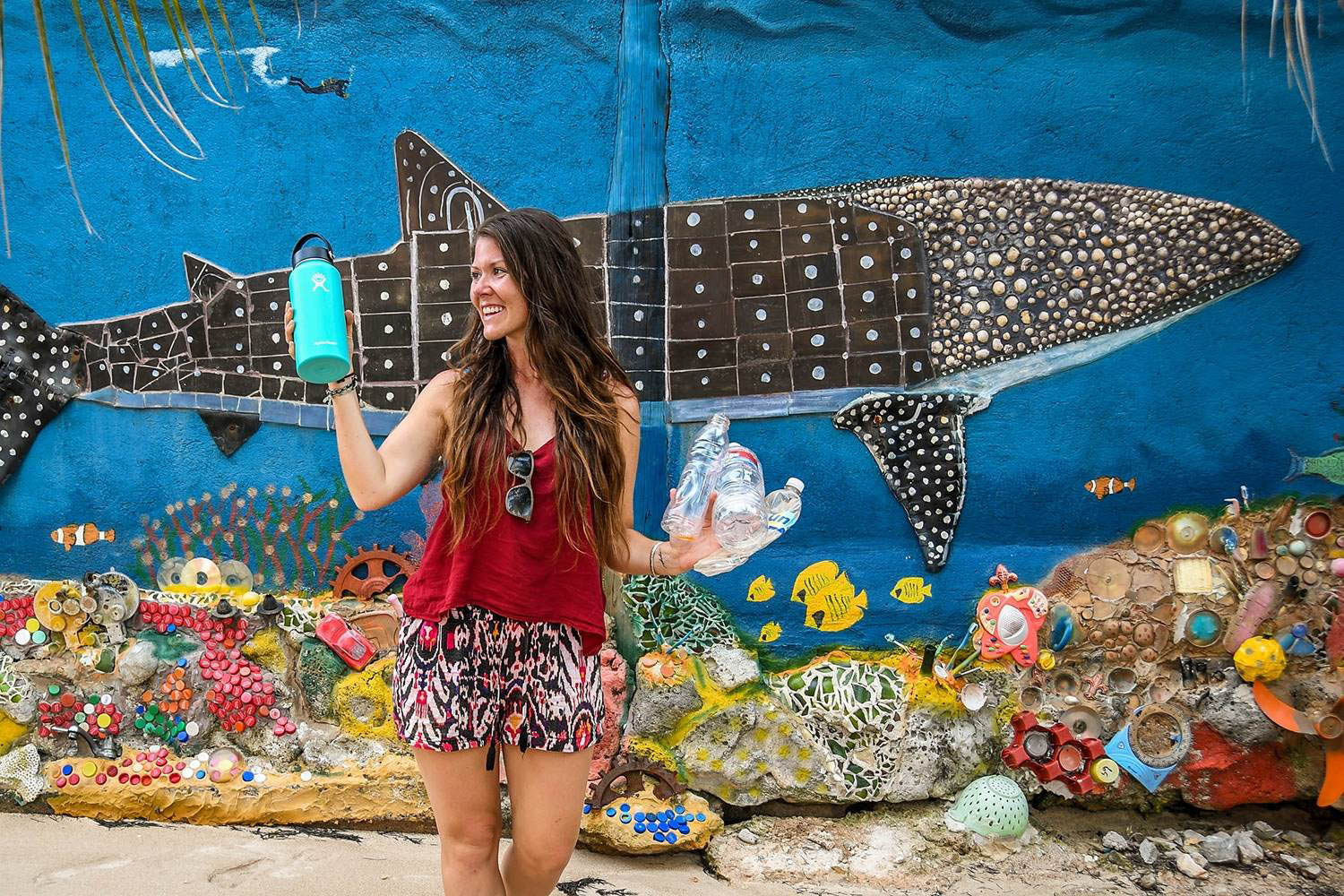
We didn’t think we used very much plastic…
…that is until we started learning more about all the sneaky ways it creeps into our lives. We were shocked (and embarrassed!) by how much plastic we actually use without even noticing.
The good news we can do something about it.
What if I told you there are simple swaps and changes you can make to reduce plastic in your everyday use?
Would you listen, or would you keep scrolling?
In this article, we’re going to break down some easy ways you can use less plastic. We’re sharing some of our favorite eco-friendly products, insider tips, and ways you can use what you already have at home to lessen your impact.
But what about recycling?
We always thought that since we recycle, we aren’t part of the problem. Right?!
But here’s a sad truth: Even when you toss something in the recycling, it often doesn’t end up being reused.
For years, many Western countries have been sending their recyclables to China to be processed. China has stopped accepting these shipments, and therefore, many recyclables are ending up in landfills… or even worse, the ocean or other waterways.
Why should I use less plastic?
I could shock you with all sorts of statistics…
- Like the fact that experts say our oceans will be made up of more plastic than fish by 2050.
- Or that plastic takes up to 1,000 years to full decompose.
- And that the infamous “trash island” in the Pacific is growing.
But in the end, it boils down to this:
Our society uses way too much plastic.
Recycling should not be our first solution. Reducing our use of plastic should.
Disclosure: This article was sponsored by EC30 — a super unique zero waste brand we’ll tell you more about in this article. In addition to introducing you to this rad brand, we’ll be sharing all sorts of practical tips to reduce plastic usage in your everyday life.
Practical approach to using less single-use plastic
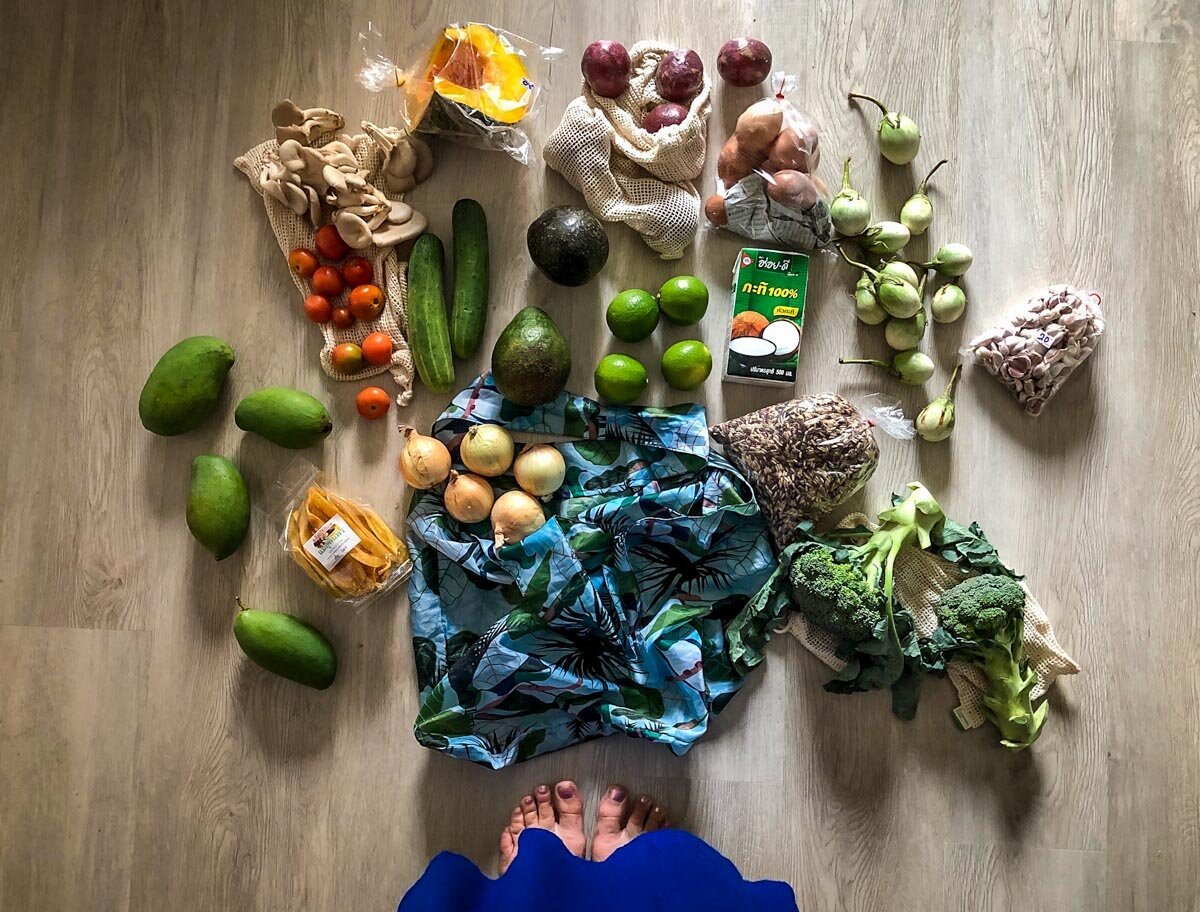
We are not perfect, and we are still learning about ways to eliminate plastic from our lives. We have spent many years blindly purchasing products with unnecessary plastics, and we continue to make mistakes.
We aren’t here to judge or to preach, but simply to show you some practical ways you can reduce plastic in your life (whether traveling or at home).
Some of these ideas may not work for you right now. That’s fine. Start with what you can change, and grow from there.
Bonus: Many of these tips can save you money too!
1. Follow the “5-R” Rule
Here’s a fun little “rule” to remember: Reduce, Refuse, Reuse then Recycle.
- Reduce: First and foremost, REDUCE plastic usage. Find alternatives you can use instead. Lucky for you, this article is packed with simple and practical ways you can cut out plastic in your life.
- Refuse: When single-use plastics are offered to you, politely REFUSE them. Try to break the habit of accepting that bottle of water or taking the straw that is handed to you along with your smoothie. Just say no.
- Reuse: When you do end up with a plastic item (it happens to all of us), REUSE it as many times as you can. Give it more than one life.
- Repair: Something broken? Instead of making it a habit of throwing things out right away, try your best to fix them first. You’d be surprised what a little duct tape or needle and thread can do.
- Recycle: As a last resort, RECYCLE the plastic items you have once they can’t be used anymore. And be sure you’re recycling them properly.
2. Stop buying plastic bottles of water
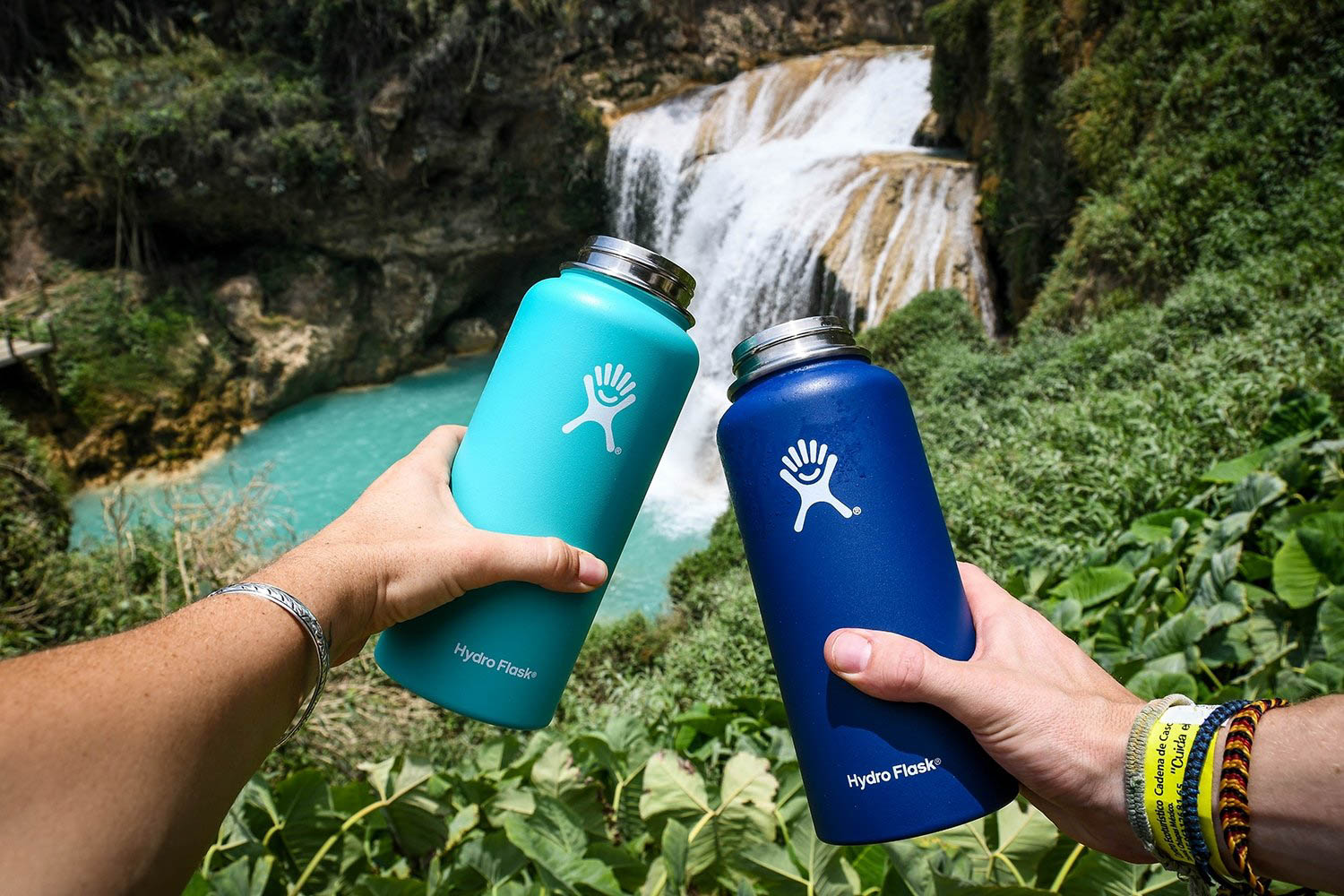
Stop buying bottles of water, and unless it’s necessary, politely decline them when they are given to you.
Instead, fill up at the tap. If you’re privileged to live in a place where the water is drinkable, great. If not, invest in a filter system.
What if the water isn’t safe to drink?
- If you’re traveling in a place where the water isn’t potable, consider packing a Steripen to make the water safe to drink.
- For home filtration systems, we personally love Big Berkey. We use it in our campervan so we can drink tap water no matter where we’re parked!
What’s the best reusable water bottle?
Answer: the one you ALREADY HAVE!
However, if you’re in the market for a new water bottle, invest in a sturdy one that you’ll be able to use for years to come. We love our Hydro Flask water bottles because they come with a lifetime warranty and they keep our water icy cold.
3. Go Zero Waste for items you use Every Day
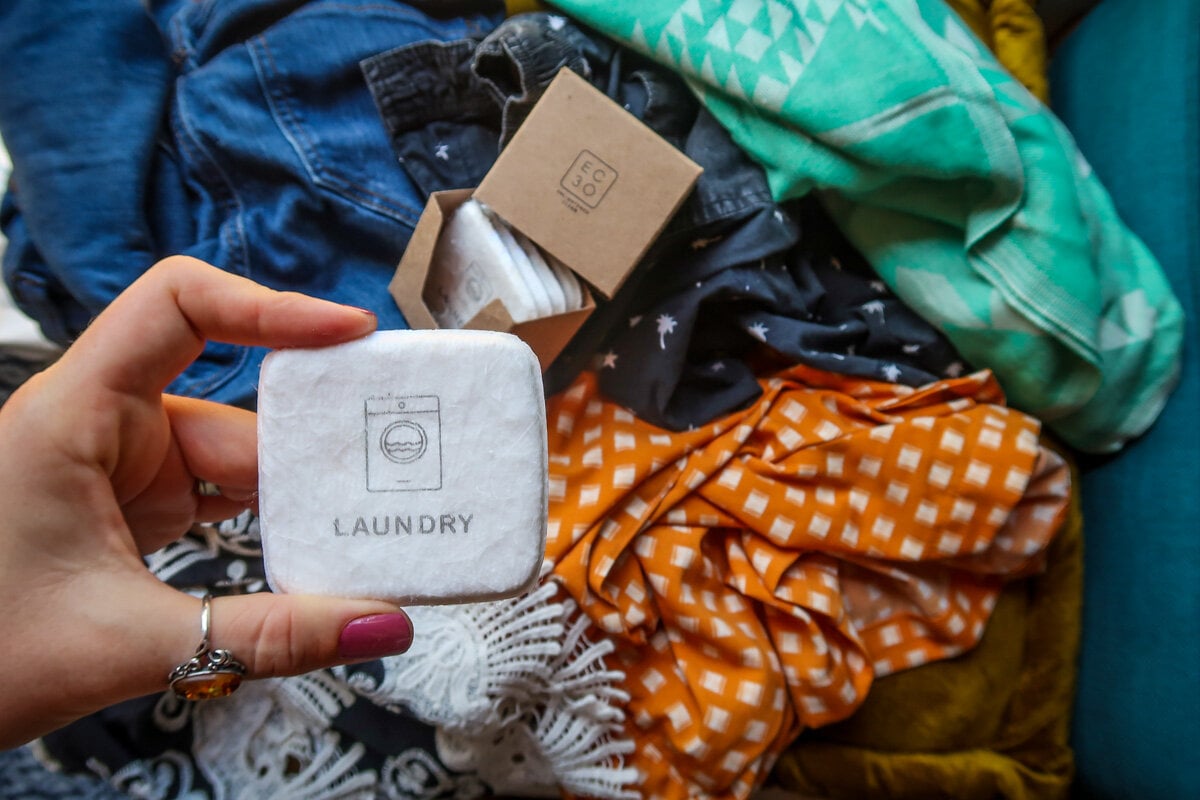
Going 100% Zero Waste is a massive and somewhat unrealistic step for many people, but you don’t have to go all in to make it count. I’ve said it once and I’ll say it again: Begin with what you can change.
Here’s how you can make the biggest impact: Swap one or two items you use regularly with a zero waste alternative.
Start by thinking about one or two items that you use often that come with plastic packaging. For example, laundry detergent, shampoo or hand soap. These are things you use on a near daily basis. Just think about the amount of plastic you could eliminate from your life if you were able to cut out the packaging…
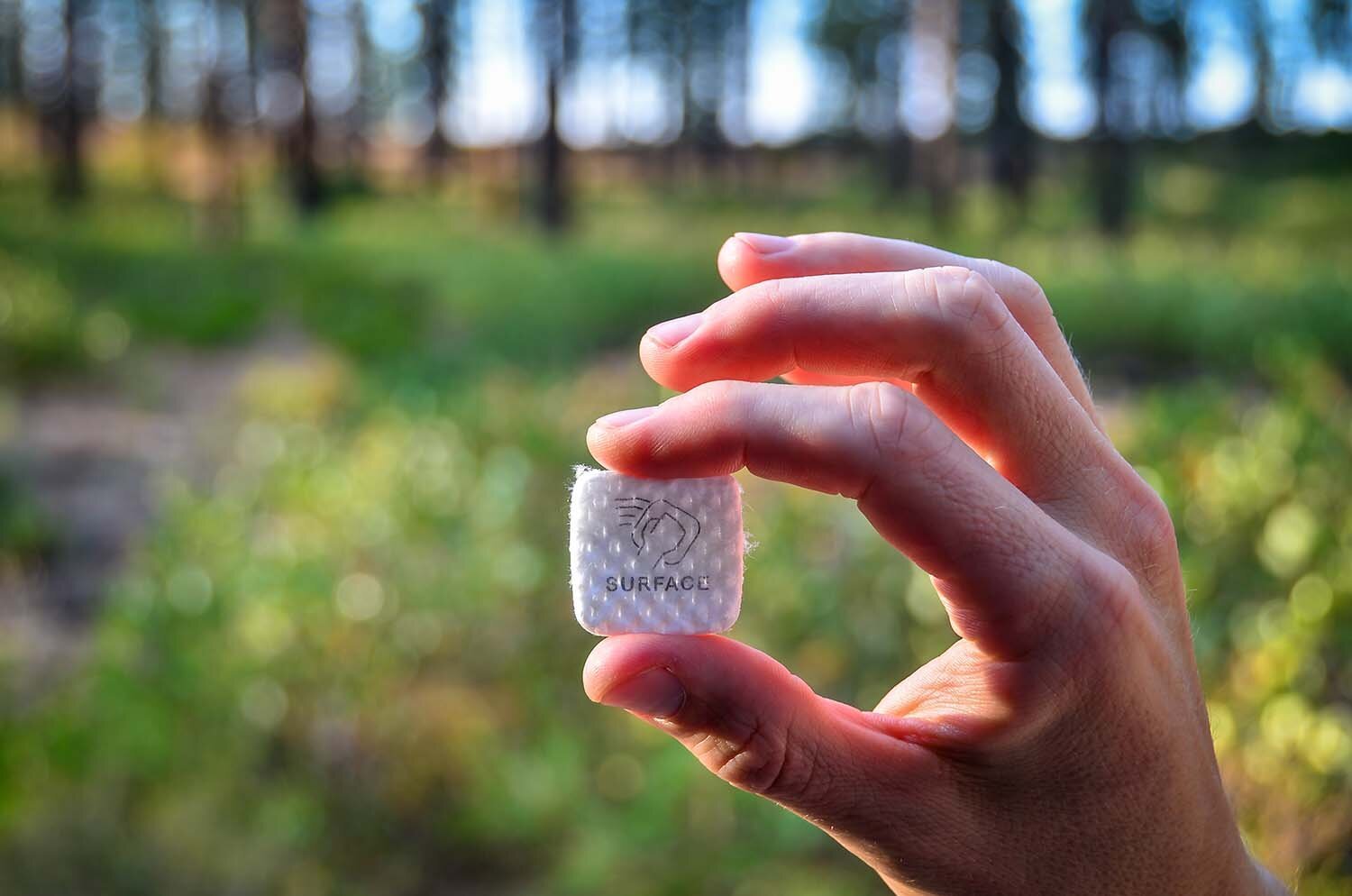
Here’s the cool part: There is a brand that has completely eliminated plastic packaging from all of its products, making it super easy to find a zero waste alternative.
EC30 has a line of household products as well as everyday self care items that are unlike anything you’ve seen before. The products come to you in “swatches” that are comprised of 100% active ingredients. This means you add water once you’re ready to use the product.
Eliminating water from their products has allowed EC30 to get rid of all plastic packaging. These products come to you in compostable cardboard instead of a jug that’ll sit in landfill far beyond your lifetime.
If you want to see these products in action, check out our video review:
HUGE Bonus: Because EC30’s products only contain active ingredients, this means they don’t need to ship water. This means their products weigh far less than the traditional versions, allowing them to get products to the consumer with 50% fewer carbon emissions. Let that sink in for a second because that’s huge! They’ve got lots of details about their journey to carbon neutral on their website.
Our favorite EC30 items:
- Laundry detergent: I’m so excited to no longer need to buy giant plastic jugs for doing laundry. That in itself is going to save us lots of plastic waste each year.
- Shampoo swatches: Ben is stoked to bring these on our next international trip (it’ll make getting through airport security a breeze!)
- Toilet bowl cleaner: Not the sexiest product to talk about, but I was super impressed with how much it foamed up and how well it cleaned our toilet. Also, I’ve never seen a zero waste option for toilet cleaner before, so it’s a really good way to make a simple plastic-free swap!
Our advice: Test out the Try it All Kit so you can sample all the different products EC30 offers and see which ones work best for you. You can get an additional $10 off when you use the coupon code: Wandering10.
After testing them all out, we are pretty confident you’ll be able to swap at least a couple products you use daily out for a zero waste version! Plus, EC30 has made it super simple with a subscription program so you can get these products delivered to you when you’re running low.
4. Try plastic-free deodorant
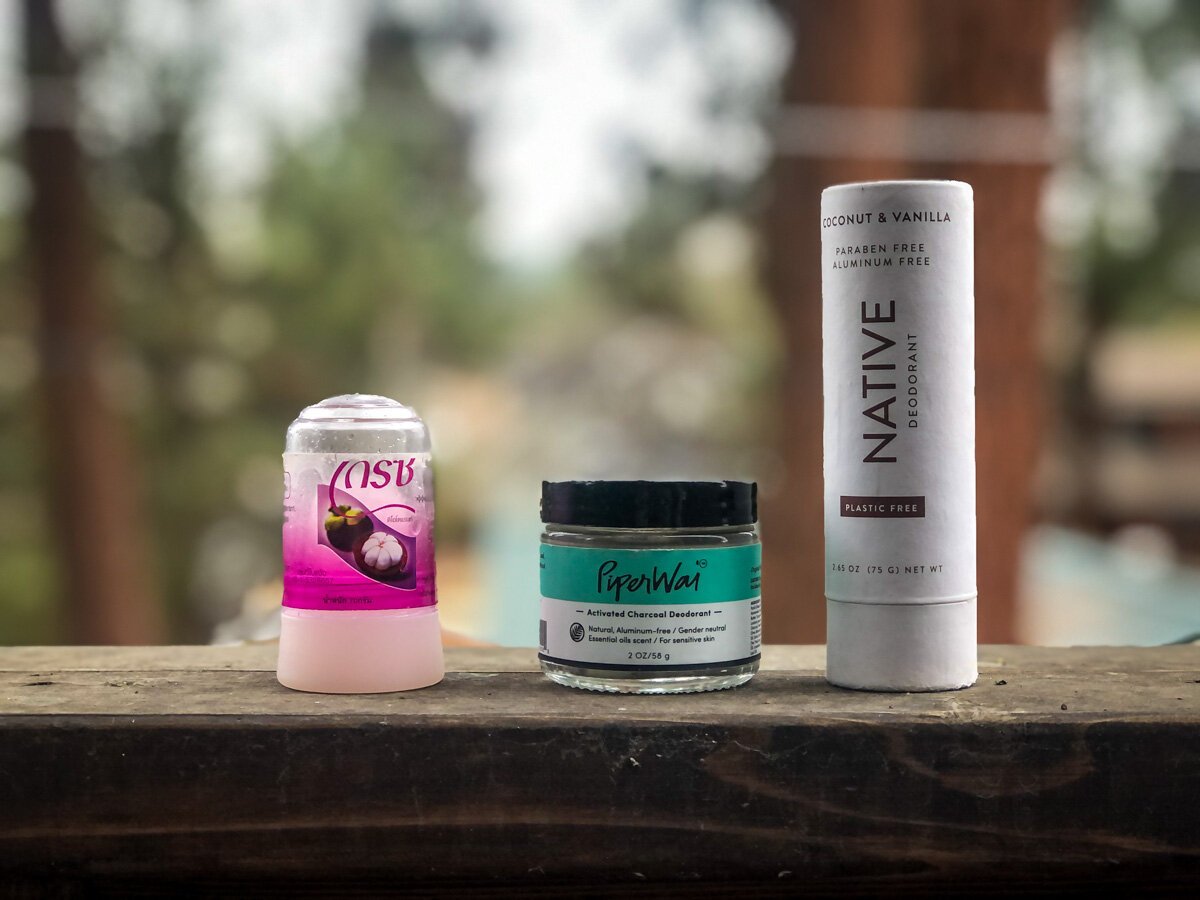
Ditch traditional deodorant that comes in plastic packaging. Instead, opt for brands that have more eco-friendly alternatives like a glass jar or a cardboard container.
Bonus: Most of the brands in eco-conscious packaging are also all-natural and don’t contain aluminum and other toxic chemicals.
Personal Experience:
- I’ve tried a ton of different natural deodorants and have had great luck with Piper Wai, which comes in a glass jar that are great for reusing.
- I also really like Native, and am happy that they now offer their deodorant in cardboard packaging. My only complaint is that the cardboard version costs $1 more than the plastic package, which seems a little backwards…
- Ben is obsessed with natural crystal deodorant. While it comes in a plastic container, each crystal lasts at least a year, meaning less plastic is thrown away. Also, once you get used to using a crystal, your body naturally doesn’t even really need deodorant anymore. Ben is proof. (And I never thought I’d say that!)
Feeling crafty? Try making your own all-natural deodorant using shea butter, arrowroot flour and essential oils. And store it in a small glass jar (reuse one you already have).
5. Travel with backup
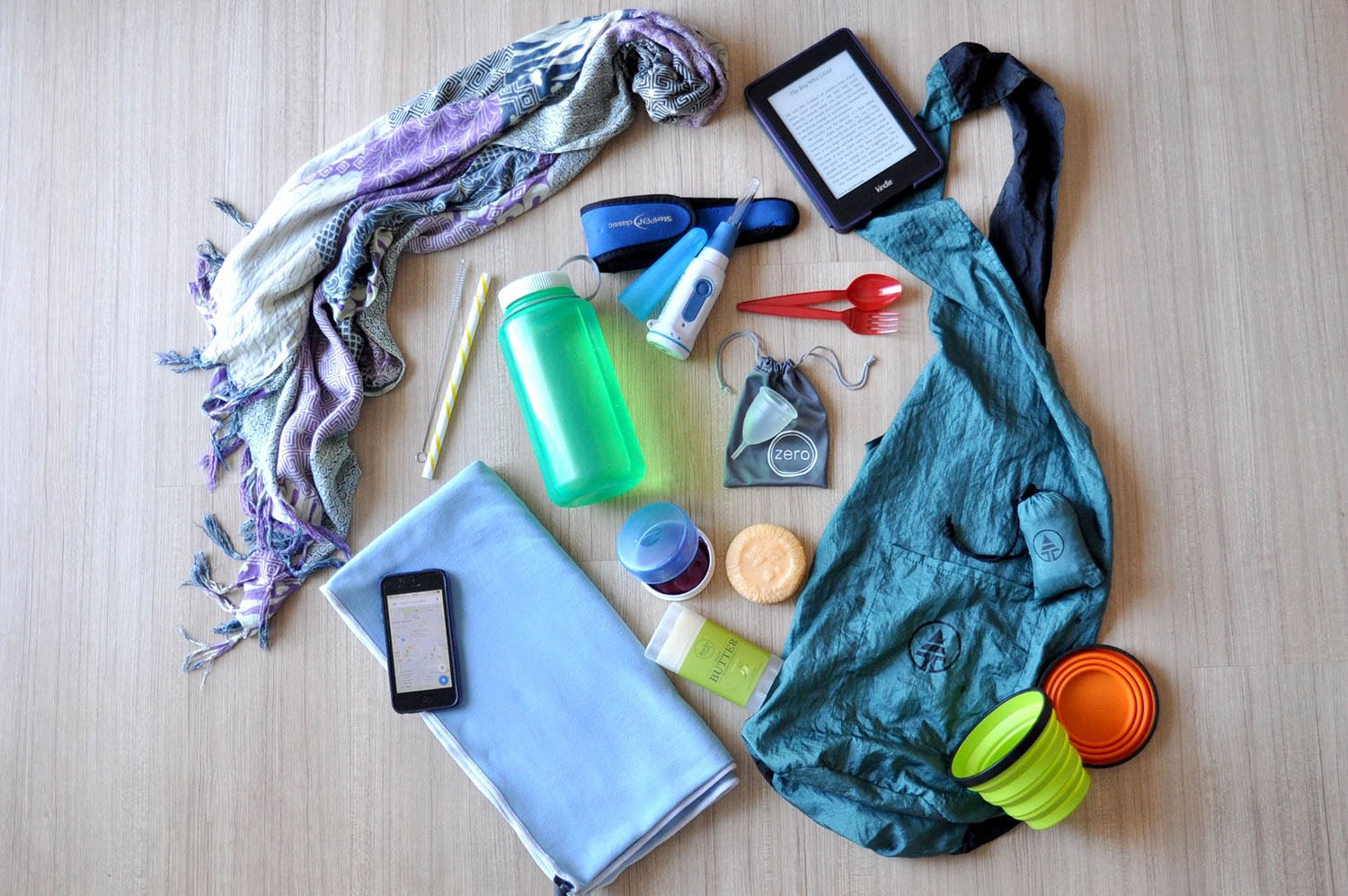
Traveling responsibly is super important to us, and we have made it our mission to create as little waste as possible when we’re far from home.
We’ve found that when traveling, it is so much easier to say no to plastic items like straws, bags and cups when we are prepared.
Psst! Check out our eco-friendly packing list so you can be more prepared on your next trip and save lots of plastic.
More eco-friendly travel tips:
- Have your reusables ready on the plane so you can (politely) refuse if they only have plastic utensils and cups.
- If you don’t speak the local language, use Google Translate and memorize (or write down!) the phrases for, “No straw/bag/water, please,” so you can politely decline single-use plastics.
6. BYO-Toiletries
While we’re on the subject of travel… the next time you stay at a hotel and you see those mini toiletries, avoid the urge to stash them in your purse. I used to look at them and think, “Oh they’re so cute!” but now I look at them and think, “What a waste of plastic!”.
And if you do need to use them (we’ve all forgotten our shampoo), refill them over and over again so you can use them on future travels.
Bonus: When you stay in hotels with the big refillable containers (it’s becoming more and more common), let them know you appreciate their efforts to reduce plastic waste!
Interesting Fact: In order to receive a 5-star rating in most markets, hotels need to provide personal toiletry bottles. This is an outdated practice, and hopefully it is done away with soon.
7. Keep reusable bags in your car
Everyone knows they should have reusable bags by now, but one of the top reasons people don’t use their bags (us included) is they forget to bring them.
Stash them in your car or your purse or your pockets so you don’t forget.
Psst! When they pack up this small, you can always carry one on you.
8. Skip the produce bags at the grocery store
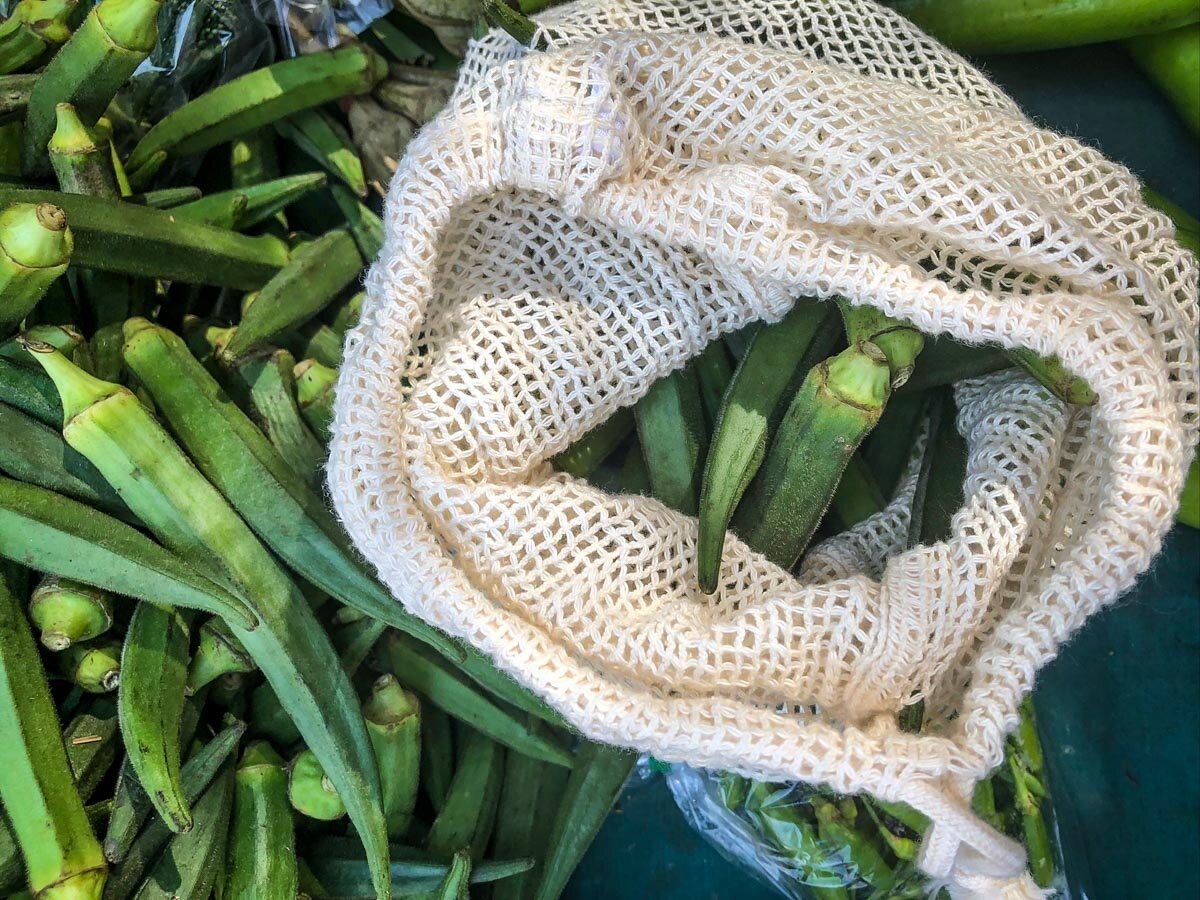
All those veggies and fruit have already been touched by many hands… Gross, I know, but a plastic bag isn’t going to help protect them much. Just sayin’!
Ditch those pesky (and unnecessary!) bags and just be sure to wash your produce extra well!
Alternative Tip: If you just can’t bring yourself to not put produce in a bag (or you want to buy a bunch of potatoes and don’t want them rolling all over your shopping cart!), try a reusable produce bag or at least reuse the plastic kind until they can’t be used anymore.
And while we’re on this topic, avoid buying the veggies on styrofoam trays wrapped in plastic when possible. So much unnecessary waste!
9. Say no to disposable straws

There’s just no need for them. ‘Nuff said. Buy a sweet reusable straw instead.
We’ve tried a bunch, but these are our favorite!
10. Invest in reusable utensils & containers
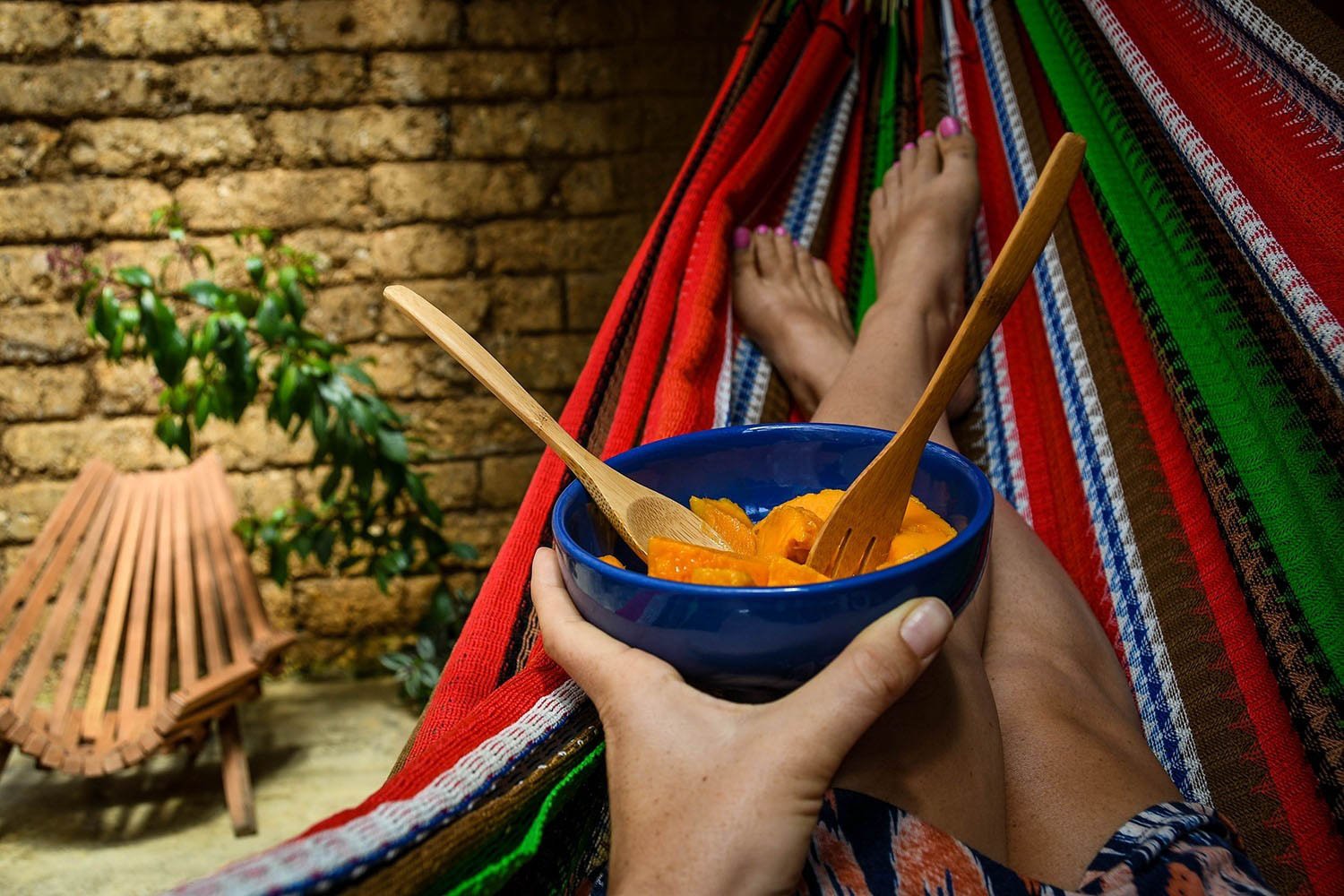
Bring your own takeaway containers, cups, coffee thermos, and utensils with you so when you get or food or drinks to-go, you won’t waste any packaging. The restaurant might even thank you for saving them the cost of to-go containers.
2020 Note: With businesses trying to prioritize hygiene more than ever, some places are not accepting reusables for the time being. But it doesn’t hurt to ask!
Here are some of our favorite reusables:
And just like with reusable bags, store a set of reusables in your car so they’re handy when you need them.
Related: Check out our eco-friendly gear in our online storefront!
11. Use what you already have
We live in a world where we’re constantly told we need more or we need the newest model. And sure, there are times when having the newest model is truly worthwhile, more efficient, or just a hell of a lot cooler! But a lot of the time this “consumer mindset” that we’re spoon-fed from an early age benefits the big brands more than benefits us.
This is true even for eco-friendly products. Do you really need a new reusable tote bag? Why buy a 7th water bottle when you already have 6 that do the job. Instead of buying a fancy eco-friendly container for takeaway food, use a container you already have at home. (yes, even if it’s plastic!).
Before heading to the store to make a purchase, ask yourself the following:
- Do I really need to buy this new?
- Do I already have something that will work?
- Could I borrow this item from someone?
Buying new doesn’t have to be your go-to option for everything. Get friendly with local thrift stores or join a “Buy Nothing” Facebook group in your area (they are an incredible resource!).
Obviously there are always going to be things you want to buy new — like underwear and toothbrushes, duh! — but there are many items that will do the same job whether new or lightly used.
12. Fix ‘er up
Get in the habit of fixing things instead of throwing them away. Think of your belongings as having a lifespan. Do everything you can to extend that lifespan and keep them out of landfills.
Oh, and it might be obvious, but getting in the habit of fixing things before going out and buying new is going to save you a heck of a lot of money.
Psst! YouTube is an amazing resource for finding tutorials that walk you through how to fix specific items.
13. Really think about your purchases
I’ll be blunt: It’s a lot of work to be a conscious consumer.
There’s a lot to think about and brands sometimes make it difficult to find the answers you’re looking for. But you don’t have to make all the changes at once. Research one product at a time to find the best brand or option, then stick with them.
Here are some things to consider when you’re making a purchase:
- Choose brands wisely: Research the brands you are loyal to. What is their stance on the environment? Do they have any sustainability practices? Are their more eco-friendly alternatives?
- Compare packaging: If there is a glass option versus a plastic, go for glass. If you have the choice of buying a large container or a small one, go for the big one (if it’s something you use often and won’t expire).
- Avoid individually packaged items: While a teeny bit more convenient, individually packaged items are incredibly wasteful. If you want things to be portioned, put them in individual jars or reusable bags.
- Buy for the long run: Ask yourself if there’s an option that’ll last longer. For example, a single plastic lighter will last you until the lighter fluid runs out. Instead, opt for a USB rechargeable lighter that you can use for years and years. And likewise, opt for better quality. It may cost a little more now, but you won’t have to replace things as frequently if you prioritize quality.
14. Don’t buy… DIY
Hey, that rhymes!
If you like getting crafty, consider learning how to make your own beauty products, household cleaners, and prepared foods.
Not only are you going to be able to save a ton of packaging (wahoo!), but you can also choose exactly what goes into each item. Say buh-bye to chemicals, toxins and additives and say hello to an all-around healthier lifestyle.
As with most of the advice on this list, start small. Think of a few things you use often that you could potentially make yourself.
For example, we eat a lot of sriracha, salad dressings and kimchi, so we started making them ourselves instead of buying them in plastic packaging. Additionally, I make a simple body scrub, face toner, and window cleaner so we don’t have to buy those either.
One of the beauties of the Internet is it’s packed with all sorts of resources and tutorials. Simply search “DIY recipe for [insert product]” and you should find tutorials to choose from!
Once you get in the habit of making things yourself you’ll see how easy it is, and how much money it can save in the long run.
Some of our favorite DIY products:
- Body scrub: coconut oil + essential oil + sugar and/or coarse salt
- Facial Toner: apple cider vinegar + tea tree oil + witch hazel
- Window cleaner: alcohol + white vinegar + water
Not in the mood to DIY? EC30 has a really nice zero waste surface cleaner. Simply drop the swatch into a reusable spray bottle filled with water, and you’ve got yourself a surface cleaner (free from fillers and nasty ingredients, by the way!).
15. Buy in bulk when possible
There are many package-free stores popping up in cities all over the world where you can buy things like pasta, quinoa, nuts, dried fruit, spices and lots more without the packaging.
Just bring a mason jar (or something similar) and fill ‘er up.
And if there isn’t a package-free store near you, ask your local grocer if they’d consider bringing in some bulk food items. You never know what kind of changes you can see when you ask for them.
Alternative options: Shop at your local farmers market or go a step further and support a specific farm in your area by signing up for a CSA box. Not only are you reducing the amount of packaging in your life, but you’re also supporting the little guys instead of a major corporation. Win win.
16. Consider buying solid toiletries
Think about all those plastic containers sitting in your bathroom… Shampoo, conditioner, face wash, toothpaste, mouthwash, lotion… I could go on.
Now, consider how many times a year you purchase each item. I know personally, that is a lot of plastic containers.
What if you could make a few swaps? Trade in that plastic bottle of shampoo for a solid bar (or a shampoo swatch, like this one!). Swap out your eye makeup remover for coconut oil (it works!). Start using a lotion bar instead of the traditional stuff.
We’ve used solid shampoo, conditioner, lotion, body wash, face wash, perfume, eye makeup remover and bug spray (to name a few). The great thing is the solid version typically comes in a cardboard box instead of plastic packaging.
Some swaps have worked amazingly, and others — like mouthwash — are things we’re just not able to find a comparable alternative. Start with what you can swap.
Bonus: The added bonus of going with solid toiletry items is they are perfect for travel and get you through airports in a cinch. Plus, you won’t have to restock with those silly little bottles a few days into your trip.
17. Try a bamboo toothbrush instead of plastic
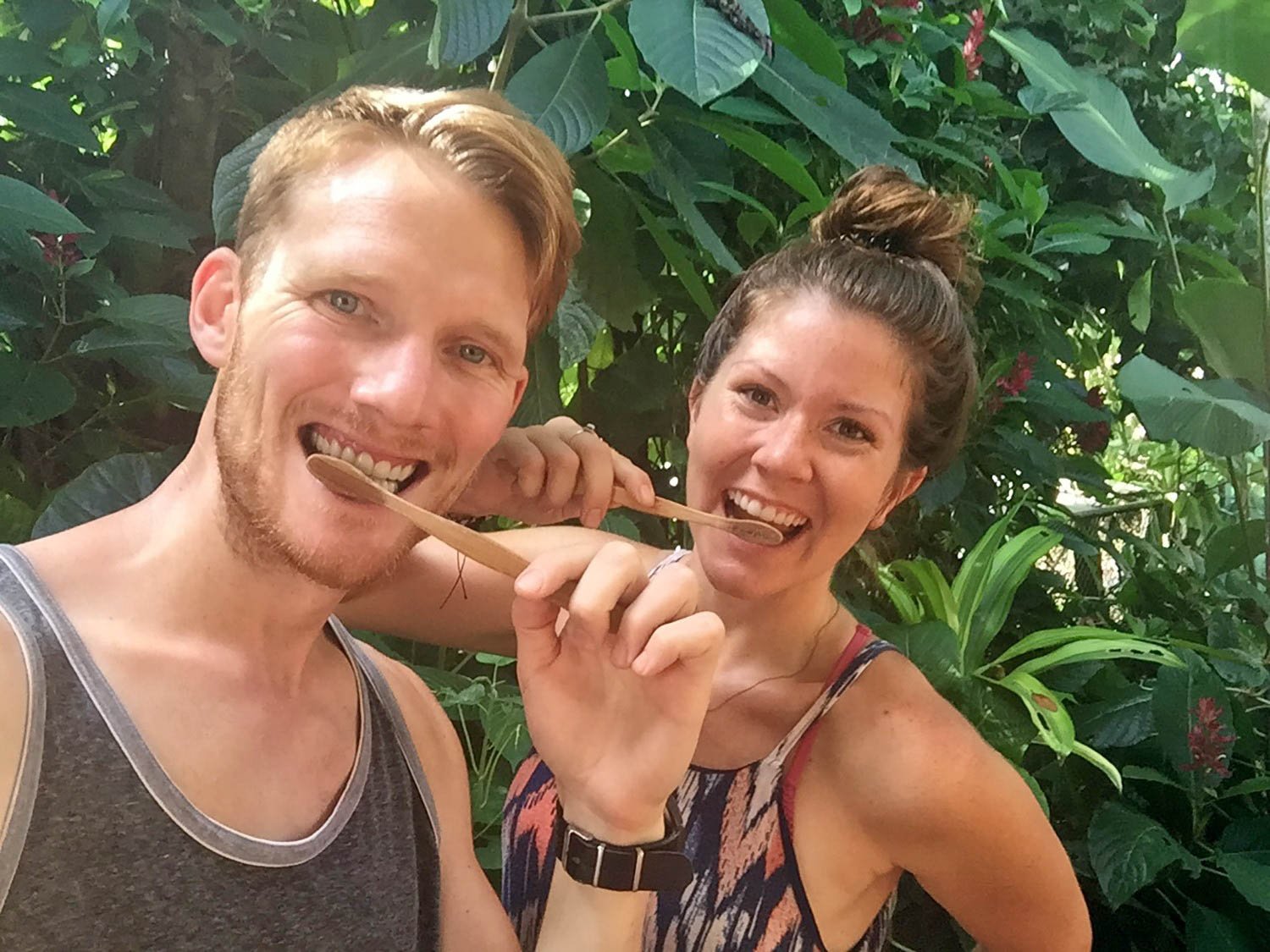
Did you know plastic toothbrushes are a very common piece of trash to find in the ocean?
Yeah, I know… we’ve been using them for years, so we’re no saints.
We each have electric toothbrushes for daily use (gotta take extra good care of those chompers!).
But for taking on short trips, bamboo toothbrushes are an environmentally friendly alternative to the disposable plastic kind.
Alternative Tip: If you love your plastic toothbrush and can’t give it up, repurpose used ones by using them to clean around your house. This will extend its life!
18. Do away with disposable razors
While we’re on the subject of bathroom products, another one to really think about is your razor choice…
There are all sorts of options, and some are better than others.
Single-use razors will pile up in the landfill, while razors with interchangeable heads create less waste over time. Even better are metal safety razors for which you just replace the blade.
18. Swap out tampons
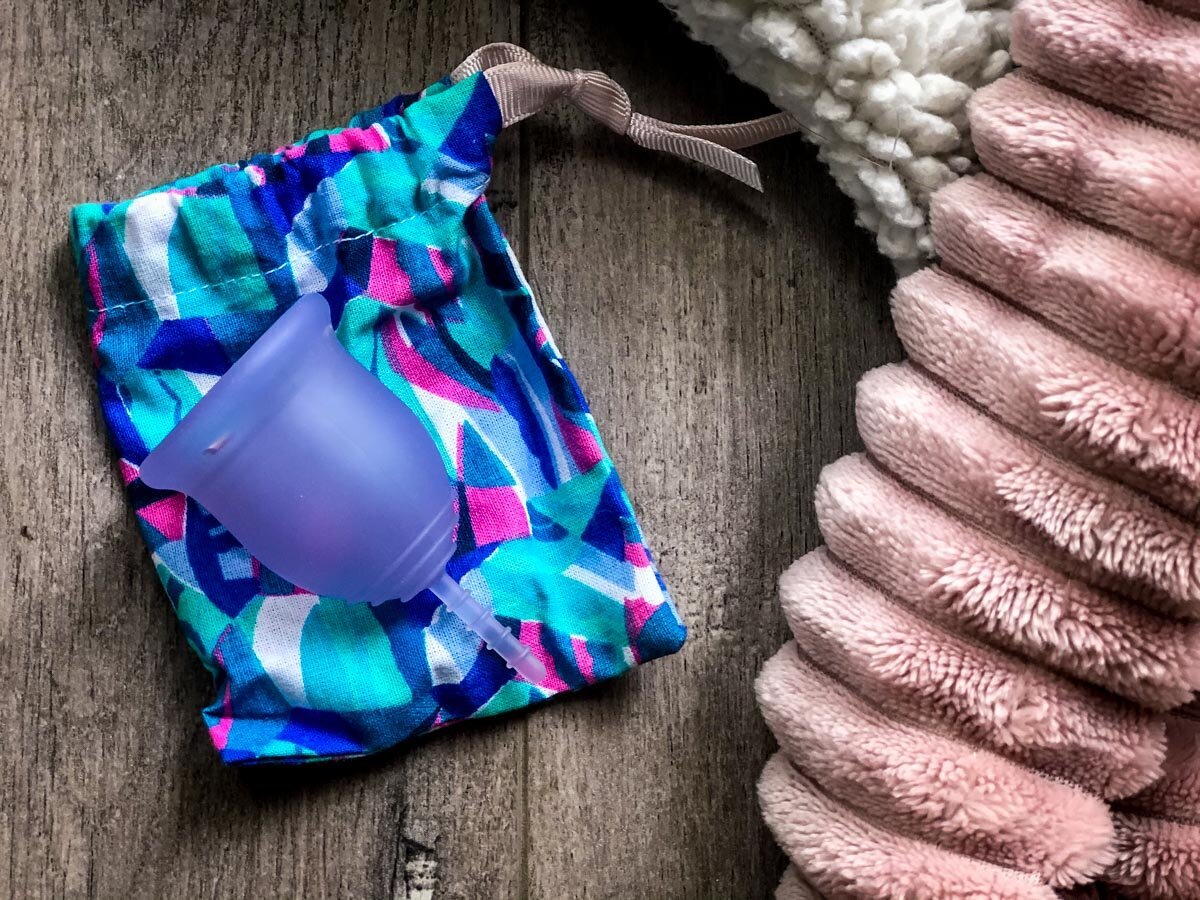
If you haven’t tried a menstrual cup, now’s the time to get on board! I’ve been using one for more than 3 years now, and it is seriously game-changing.
Not only will you never need to buy tampons again (which will save you SO MUCH money and all those plastic applicators) but you can leave it in much longer than a tampon, which is very convenient, especially when traveling.
Alternative Tip: If you just can’t get on board with this idea, try swapping traditional tampons for one that doesn’t have an applicator, like the OB brand. Or at the very least, opt for a cardboard applicator instead of plastic.
20. Take a close look at your cotton swabs
Is the stick between the two cotton bits made of plastic? If so, here’s a super simple swap: Just buy the kind with a paper stick next time!
There are also reusable silicone swabs out there if you want to eliminate the need for the disposable kind.
21. Avoid products with “microbeads”
One of my favorite face washes in the past was from Neutrogena, and it was packed with these little “microbeads”. I loved how they felt when I washed my face, and I bought that product over and over again.
But you guessed it… those little beads are made from tiny pieces of plastic.
Microbeads get washed into the drain and are too small to be filtered out. They enter our waterways and wind up in lakes and streams and in the tummies of unsuspecting fish. And then we eat the fish, creating a disgustingly depressing food chain problem…
The great thing, is you can still get exfoliation without the plastic microbeads. Try a natural option, like St. Ives Apricot Scrub. This is another old favorite, but since it comes in a plastic container, you could try making your own instead. Here are a few recipes I’m excited to try.
And when it comes to making body scrubs, a simple combination of coconut oil, essential oils and a natural exfoliant like coffee grounds, coarse salt or cane sugar does the trick quite well.
On a Positive Note: We are happy to see that the UK has taken steps to eliminate all products with microbeads. Hopefully some other countries will follow their lead.
22. Stop buying plastic wrap & baggies
These single-use items are so wasteful. They get used once, then end up in a landfill.
The great news is there are some really great alternatives that can be used over and over and over…
- Instead of plastic wrap, save your leftovers using silicone lids or eco-friendly beeswax wrap. We have both and like them for different purposes.
- Instead of disposable baggies, purchase reusable silicone bags. They’re awesome!
- Stasher is one of the best brands on the market, but these are a good budget-friendly option that we personally use.
This simple kitchen swap will save a lot of plastic, and it’ll also save you money over time.
23. Wash your synthetic fabrics in a special bag
Did you know synthetic clothing or fabrics break down each time you wash it and small pieces of plastic make it to our waterways? Pieces of micro-plastics have been found in even the most remote parts of the oceans. Fish consume them, and we consume the fish. So, essentially we’re consuming tiny bits of plastic. Yum.
We all have clothing made from synthetic fabrics (polyester, acrylic, nylon, rayon, spandex, etc.). This covers most athletic clothes.
One option for reducing your impact on the environment is to stop purchasing these types of fabrics, but truthfully, athletic ware made from natural materials just aren’t the same quality.
Stop those micro-plastics from reaching the waterways by washing all synthetic fabrics in a specialized bag (GuppyFriend) made to trap them. What a simple solution!
24. Switch to wool dryer balls
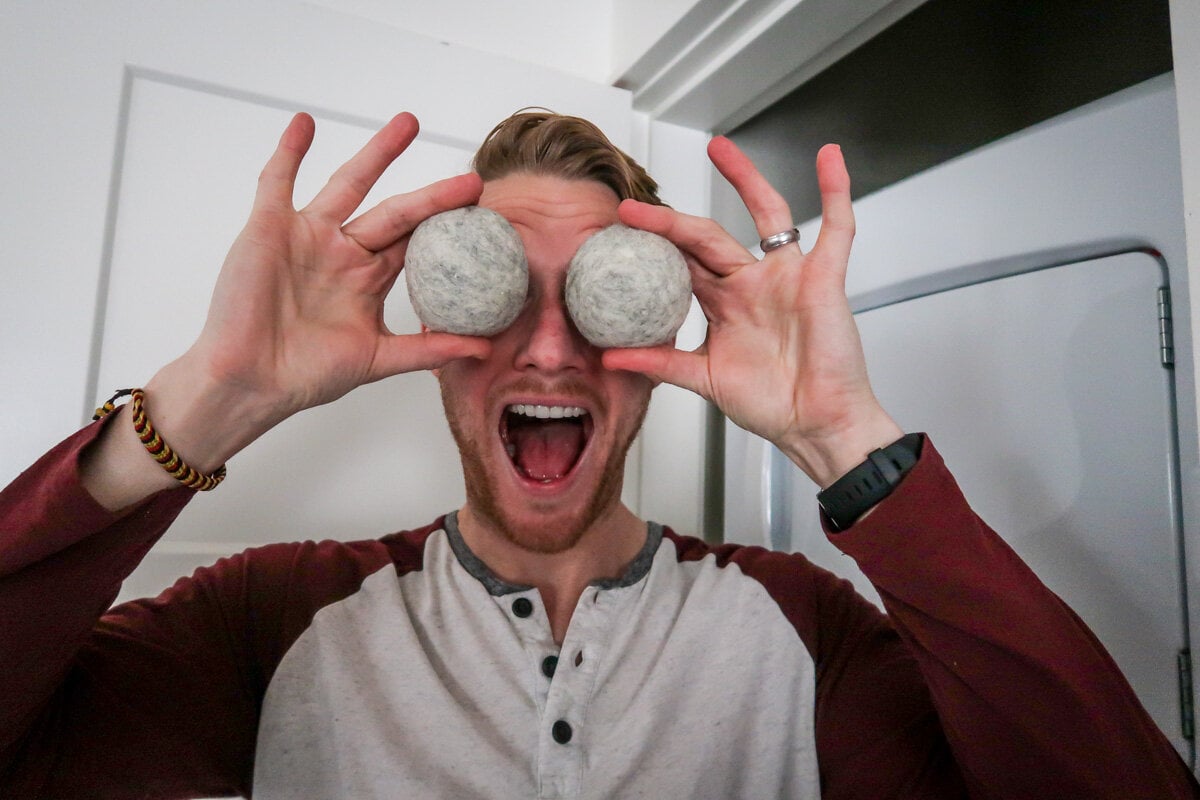
Dryer sheets are another source of — you guessed it — microplastics.
The good news is there are some great (inexpensive) alternatives.
Instead of dryer sheets, get a set of eco-friendly wool dryer balls. Over time, it’ll save you money, and they do the same job.
Insider Tip: If you miss having your clothes come out of the dryer smelling like a fresh meadow or mountain air, put a few drops of your favorite essential oils on the balls before tossing them into the dryer. Lemongrass + Lavender is my personal fave!
Also, we used to like putting dryer sheets in our backpacks and packing cubes to keep our clothes smelling fresh while traveling. Now, we use a little sachet filled with lavender. Perfect swap!
25. Rethink your coffee
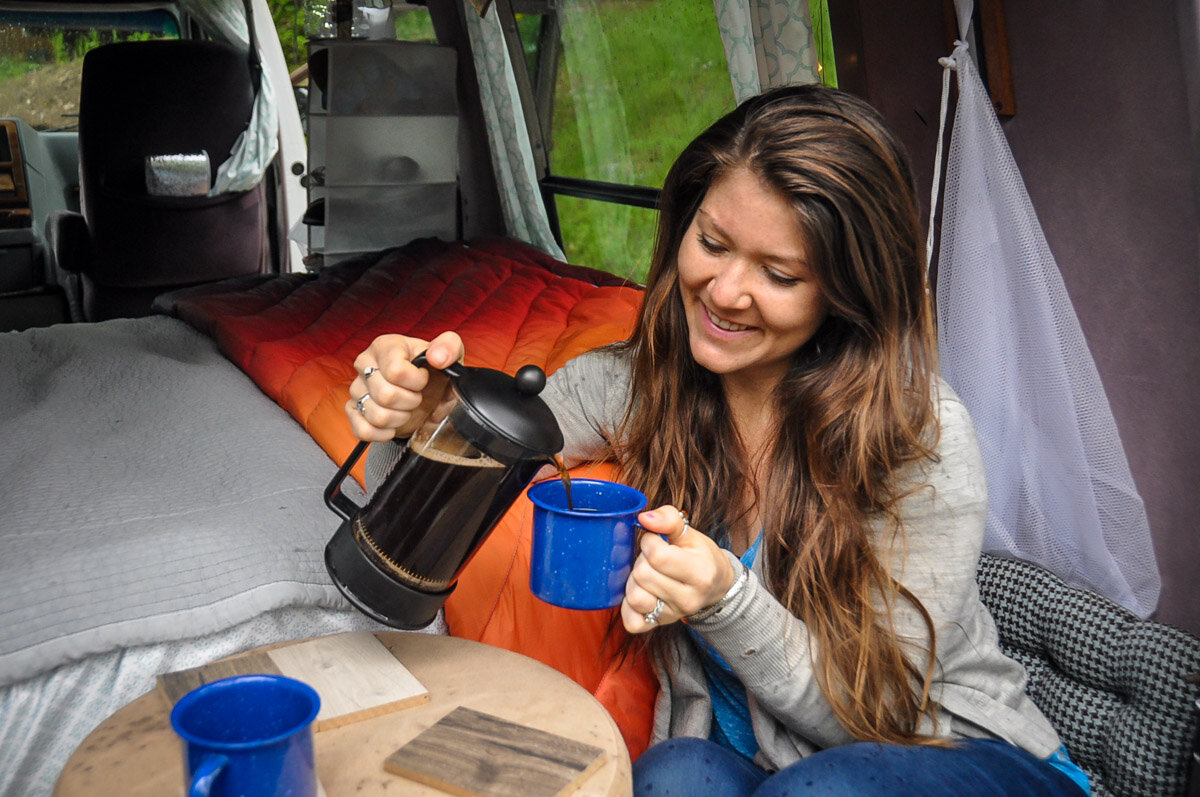
This may be a sore subject for some, but those K-Cup machines — while convenient — create a ton of waste.
Every time you brew a cup, a puppy dies… err… a (super unnecessary) plastic container gets added to a landfill.
If you already have one of these machines, I’m not saying to go throw it away. That would just add an even bigger amount of waste to the landfill. But if you’re perhaps debating what type of coffee maker to buy, go with something that won’t create garbage with each cup.
Psst! French presses, percolators, or pour over styles are great alternatives. Plus, they make way better coffee than K-cups in our opinion!
26. Share your opinions
When one person makes changes to their lifestyle, it can add up to make a big difference over time. But when a company makes shifts, the difference is magnified.
As consumers, we have a lot of power, and over time, companies will hear our collective voice if we speak up. This is where major change will start to happen.
- The good: When a company or a small business is taking steps to reduce plastic usage (or otherwise reduce their impact on the environment), commend them for it. Support them by buying their products, email them, tell your friends about them. This can go a long way.
- The bad: On the other hand, if a company has a product you love that comes wrapped in unnecessary plastic, contact them to see if there’s a way to reduce this. (Tip: Being polite in situations like this goes a long way!)
What you can do now

We hope you’re able to find a few tips in this article that seem easy to add to your life to reduce plastic usage.
Instead of trying them all at once, take it one step at a time. Little by little, you’ll start to reduce your plastic consumption and you’ll find that these simple swaps can actually be quite satisfying. And before you know it, they’ll just be a part of everyday life.
We say this time and time again, but we are FAR from perfect. And ya know what? We probably never will be. But it’s okay, because striving for perfection is exhausting and can cause you to give up eventually.
We try to do our part and learn about more ways we can reduce our impact. And we try to be better than yesterday.
Another thing to point out is that plastic is just one part of the puzzle. There are other ways to reduce our impact on the environment that have nothing to do with plastic.
Here are just a few:
- try composting
- be mindful about your meat consumption
- reduce the amount of fossil fuels you use
- pick up trash when you have the chance
- learn about your carbon footprint and ways you can lessen it
We can each make a difference, and even the smallest acts count.
A note on Plastic & Privilege
We want to take a moment to address something that isn’t always talked about when it comes to plastic or the environment: Privilege.
In many ways, the eco-conscious community tends to be centered around the white, upper-class experience, and the conversation can get very judgmental. We’ve been part of the problem.
But the truth is what is an “easy swap” for one person just might not be possible for another. Without diving too deep into it, where you live can make a huge impact on what resources are even available to you. For example, some neighborhoods have affordable grocery stores with many zero-waste options, while other neighborhoods don’t have this luxury.
Plus, other life struggles come into play as well. When you’re living paycheck to paycheck, caring for a sick family member, or struggling with mental health, thinking about how to reduce your plastic usage likely won’t make it to the top of your priority list.
To be honest, we’re sick of the judgmental “all or nothing” approach that often goes hand-in-hand with the eco-conscious community.
All this is not to undermine the urgency and importance of reducing the amount of plastic we use. Our earth is hurting, and change is necessary.
But we do want to remind you (and ourselves!) that everyone is coming from different places of privilege.
If you’re able to make some big changes in your lifestyle, we hope this article lights your fire and gives you some simple, actionable tips to make a difference.
Interested in learning more about Responsible Travel?
We are passionate about traveling in a way that is ethical, sustainable and responsible. Visit our resources page on Responsible Tourism to learn more about how you can create a positive impact everywhere you travel! Or read some of our favorite articles on responsible travel below…
- How to Volunteer Abroad Ethically
- Eco-Friendly Travel Gear Packing List
- Eco-Friendly Road Trip Tips
- How To Plan a Sustainable and Eco-Friendly Trip
Be sure to share this article on Pinterest!
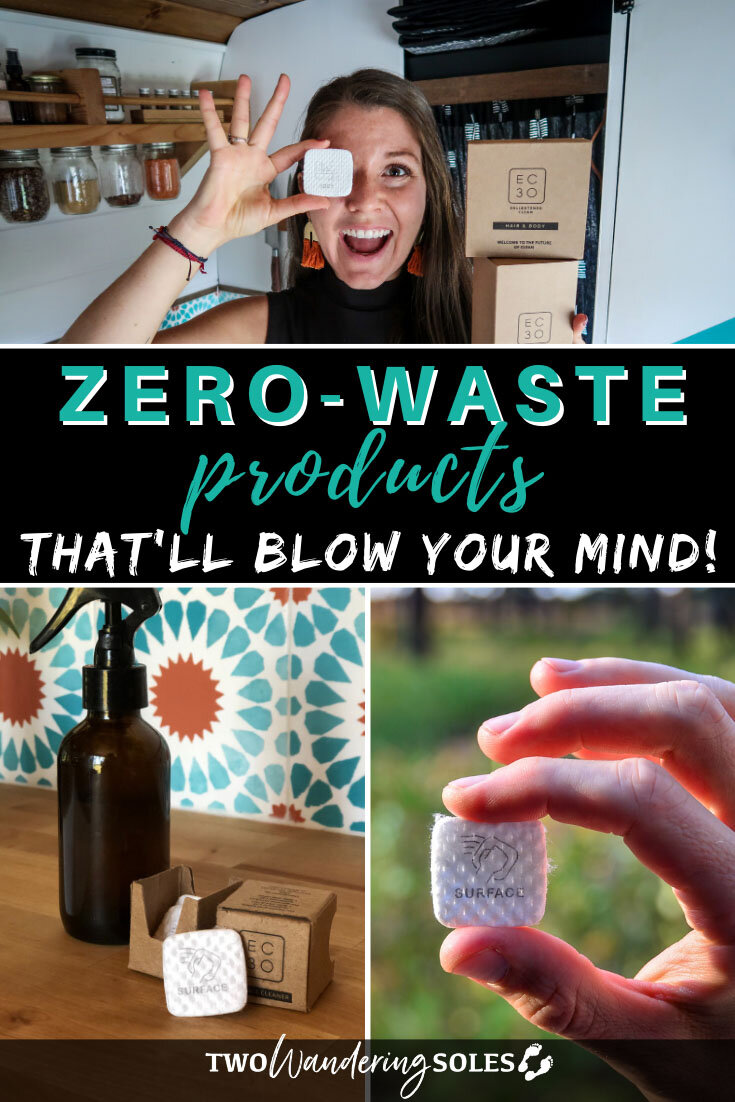
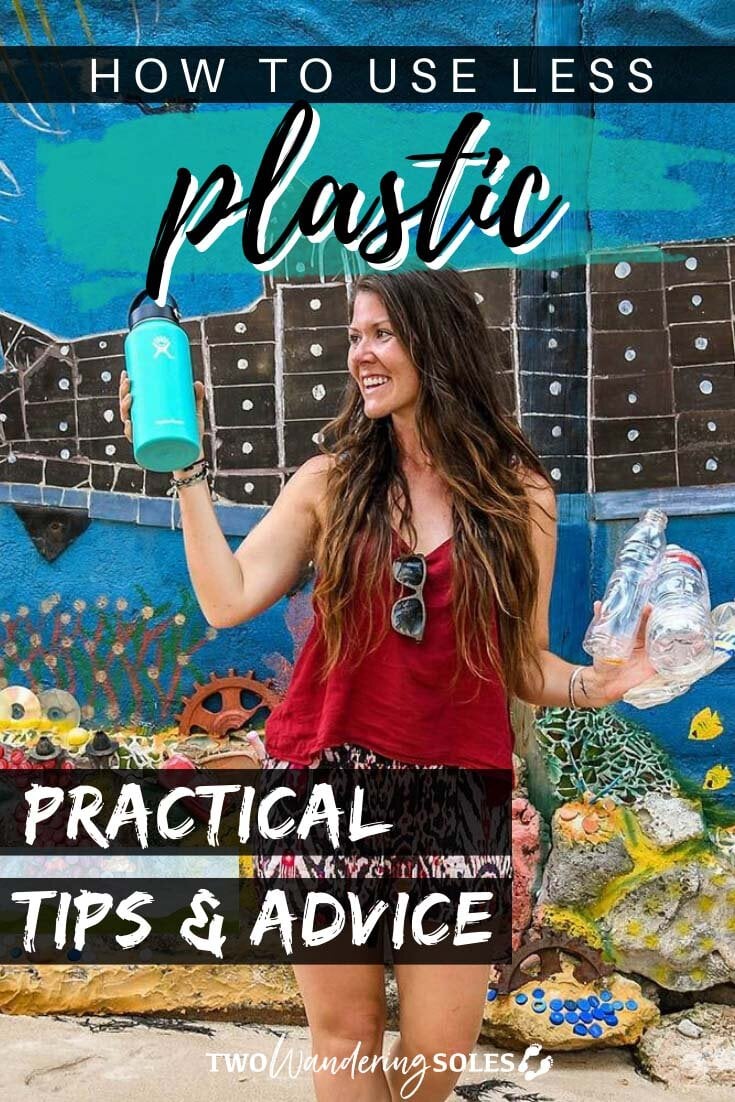
We want to hear from you!
We also want to learn from you. We have so much room for improvement and are constantly seeking ways we can be better. So share your plastic-free tips below!

I’m from a West African country… I really wish many of my people could read this.
These are great tips! Replacing single-use plastic with reusable products is a great first step. I’ve curated a collection of well-designed products that also help you use/waste less plastic. You can filter the products by features such as plastic-free packaging and reusable items. Check out omitplastic.com.
I have a question about the DIY suggestions. It’s great to make your own glass cleaner, for example, but don’t many of the ingredients (alcohol, vinegar, etc) come in plastic containers? This is where I’m torn about DIY.
Wonderful article. It is definitely required in this day and age where plastic has become such a menace and causes so much harm to the environment. You have some brilliant ideas here to reduce the use of plastic. I have been following many of them such as switching to steel and glass bottles, using recyclable cloth bags for shopping and groceries, using reusable containers, and DIYs, among others. Looking forward to your next post. This was a fantastic read.
Stop useing plastic pens when ever possible and GO TO PENCILS
That’s a good one too! Using a pencil is easier for erasing mistakes too 😉 Thanks for sharing, Richard!
So much good info here! It’s crazy how many people I meet on the road that have never even heard of solid shampoo. Incidentally, I had no idea about the microbeads – I’ll certainly be making a point to avoid them in the future. Thanks for sharing!
Hey Daniel, it’s so true that the more you learn, the more you start to care. And that is where change can happen! Thanks for your comment!
I love your 4-Rs. I would recommend adding a 5th, Repair.
Yes, Kevin! Added Repair to the list! Thank you!
I have read your full post, nicely written by you I want to say that this is a very nice blog with great information and beautiful images thank you to share this.
Thank you so much for your kind words about our website!
Awesome post! ? We travel with refillable water bottles and coffee cups ? we also use shampoo bars, soap bars, salt blocks as deodorant and bamboo toothbrushes ? we avoid sun cream and when we really need to use some, we use a non-toxic cream ☀️ we take cloth bags and rucksacks shopping AND we are always the annoying couple with all our veggies rolling around at the till ? we love travelling more consciously and are always learning too! Thank you so much for sharing ?
That’s so great to hear Karen! Way to go, keep it up!
I so have to try a shampoo bar! And a conditioner one. I heard of them not too long ago and haven’t been able to find one yet but I’m going home today so I can order them there. Is it true that they last longer than liquid shampoo? Which ones are you using? They sound so much more convenient to carry and I also wouldn’t have to buy all those shampoo and conditioner bottles anymore.
I have heard that sunscreen is also available in a solid form. I think it comes in a plastic container, though, and I am a bit afraid it melts if it gets too hot. But hopefully, good alternatives will pop up soon.
Meanwhile, I try to reduce my waste as much as possible. I sometimes need to use plastic bags, if only to store my insect repellent that has a tendency of leaking. But I try to reuse my plastic garbage as much as possible, even if it’s not always possible or sometimes, I just need that bag because I forgot my own.
Hey Ilona! Thanks for all you do to reduce plastic use! I use Lush brand shampoo and conditioner bars and I love them! One bar typically lasts me three months (shampooing my hair every other day or once in three days). I haven’t found a good solid sunscreen that I like so let me know if you find one 🙂 Also, have you tried to solid bug repellant? It would solve your need for a plastic bag around a leaky bottle. Thanks again for all that you’re doing!
Love your blog and hearing about all your travels.
Have you tried the mesh produce bags from flip&tumble? They work really great for produce or bigger bulk items like rice or nuts (especially if your store doesn’t let you use a tare weight for jars). flipandtumble.com/products/produce-bags
Thanks Amanda, we hadn’t heard of them but thanks for the tip. Always good to hear other ways to reduce plastic use.